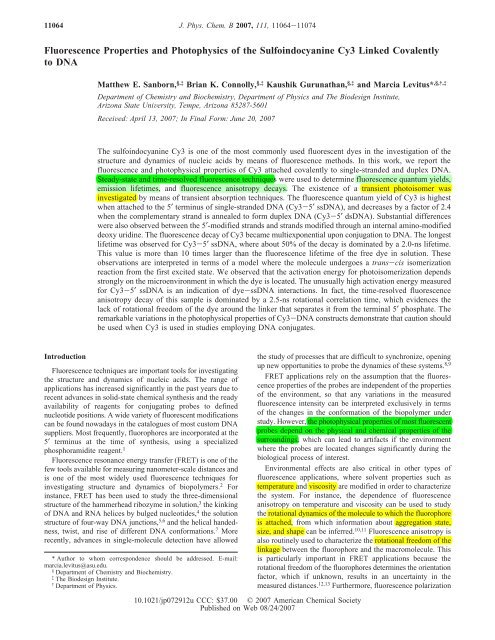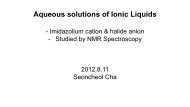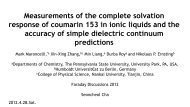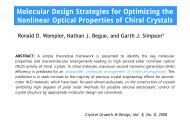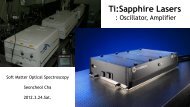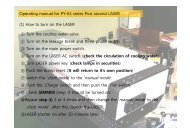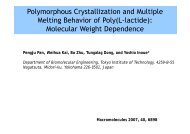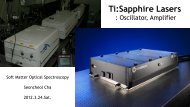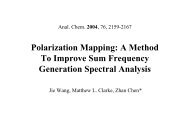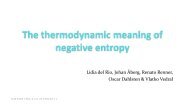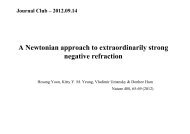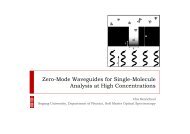Fluorescence Properties and Photophysics of the Sulfoindocyanine ...
Fluorescence Properties and Photophysics of the Sulfoindocyanine ...
Fluorescence Properties and Photophysics of the Sulfoindocyanine ...
Create successful ePaper yourself
Turn your PDF publications into a flip-book with our unique Google optimized e-Paper software.
11064 J. Phys. Chem. B 2007, 111, 11064-11074<br />
<strong>Fluorescence</strong> <strong>Properties</strong> <strong>and</strong> <strong>Photophysics</strong> <strong>of</strong> <strong>the</strong> <strong>Sulfoindocyanine</strong> Cy3 Linked Covalently<br />
to DNA<br />
Introduction<br />
Mat<strong>the</strong>w E. Sanborn, §,‡ Brian K. Connolly, §,‡ Kaushik Gurunathan, §,‡ <strong>and</strong> Marcia Levitus* ,§,†,‡<br />
Department <strong>of</strong> Chemistry <strong>and</strong> Biochemistry, Department <strong>of</strong> Physics <strong>and</strong> The Biodesign Institute,<br />
Arizona State UniVersity, Tempe, Arizona 85287-5601<br />
ReceiVed: April 13, 2007; In Final Form: June 20, 2007<br />
The sulfoindocyanine Cy3 is one <strong>of</strong> <strong>the</strong> most commonly used fluorescent dyes in <strong>the</strong> investigation <strong>of</strong> <strong>the</strong><br />
structure <strong>and</strong> dynamics <strong>of</strong> nucleic acids by means <strong>of</strong> fluorescence methods. In this work, we report <strong>the</strong><br />
fluorescence <strong>and</strong> photophysical properties <strong>of</strong> Cy3 attached covalently to single-str<strong>and</strong>ed <strong>and</strong> duplex DNA.<br />
Steady-state <strong>and</strong> time-resolved fluorescence techniques were used to determine fluorescence quantum yields,<br />
emission lifetimes, <strong>and</strong> fluorescence anisotropy decays. The existence <strong>of</strong> a transient photoisomer was<br />
investigated by means <strong>of</strong> transient absorption techniques. The fluorescence quantum yield <strong>of</strong> Cy3 is highest<br />
when attached to <strong>the</strong> 5′ terminus <strong>of</strong> single-str<strong>and</strong>ed DNA (Cy3-5′ ssDNA), <strong>and</strong> decreases by a factor <strong>of</strong> 2.4<br />
when <strong>the</strong> complementary str<strong>and</strong> is annealed to form duplex DNA (Cy3-5′ dsDNA). Substantial differences<br />
were also observed between <strong>the</strong> 5′-modified str<strong>and</strong>s <strong>and</strong> str<strong>and</strong>s modified through an internal amino-modified<br />
deoxy uridine. The fluorescence decay <strong>of</strong> Cy3 became multiexponential upon conjugation to DNA. The longest<br />
lifetime was observed for Cy3-5′ ssDNA, where about 50% <strong>of</strong> <strong>the</strong> decay is dominated by a 2.0-ns lifetime.<br />
This value is more than 10 times larger than <strong>the</strong> fluorescence lifetime <strong>of</strong> <strong>the</strong> free dye in solution. These<br />
observations are interpreted in terms <strong>of</strong> a model where <strong>the</strong> molecule undergoes a trans-cis isomerization<br />
reaction from <strong>the</strong> first excited state. We observed that <strong>the</strong> activation energy for photoisomerization depends<br />
strongly on <strong>the</strong> microenvironment in which <strong>the</strong> dye is located. The unusually high activation energy measured<br />
for Cy3-5′ ssDNA is an indication <strong>of</strong> dye-ssDNA interactions. In fact, <strong>the</strong> time-resolved fluorescence<br />
anisotropy decay <strong>of</strong> this sample is dominated by a 2.5-ns rotational correlation time, which evidences <strong>the</strong><br />
lack <strong>of</strong> rotational freedom <strong>of</strong> <strong>the</strong> dye around <strong>the</strong> linker that separates it from <strong>the</strong> terminal 5′ phosphate. The<br />
remarkable variations in <strong>the</strong> photophysical properties <strong>of</strong> Cy3-DNA constructs demonstrate that caution should<br />
be used when Cy3 is used in studies employing DNA conjugates.<br />
<strong>Fluorescence</strong> techniques are important tools for investigating<br />
<strong>the</strong> structure <strong>and</strong> dynamics <strong>of</strong> nucleic acids. The range <strong>of</strong><br />
applications has increased significantly in <strong>the</strong> past years due to<br />
recent advances in solid-state chemical syn<strong>the</strong>sis <strong>and</strong> <strong>the</strong> ready<br />
availability <strong>of</strong> reagents for conjugating probes to defined<br />
nucleotide positions. A wide variety <strong>of</strong> fluorescent modifications<br />
can be found nowadays in <strong>the</strong> catalogues <strong>of</strong> most custom DNA<br />
suppliers. Most frequently, fluorophores are incorporated at <strong>the</strong><br />
5′ terminus at <strong>the</strong> time <strong>of</strong> syn<strong>the</strong>sis, using a specialized<br />
phosphoramidite reagent. 1<br />
<strong>Fluorescence</strong> resonance energy transfer (FRET) is one <strong>of</strong> <strong>the</strong><br />
few tools available for measuring nanometer-scale distances <strong>and</strong><br />
is one <strong>of</strong> <strong>the</strong> most widely used fluorescence techniques for<br />
investigating structure <strong>and</strong> dynamics <strong>of</strong> biopolymers. 2 For<br />
instance, FRET has been used to study <strong>the</strong> three-dimensional<br />
structure <strong>of</strong> <strong>the</strong> hammerhead ribozyme in solution, 3 <strong>the</strong> kinking<br />
<strong>of</strong> DNA <strong>and</strong> RNA helices by bulged nucleotides, 4 <strong>the</strong> solution<br />
structure <strong>of</strong> four-way DNA junctions, 5,6 <strong>and</strong> <strong>the</strong> helical h<strong>and</strong>edness,<br />
twist, <strong>and</strong> rise <strong>of</strong> different DNA conformations. 7 More<br />
recently, advances in single-molecule detection have allowed<br />
* Author to whom correspondence should be addressed. E-mail:<br />
marcia.levitus@asu.edu.<br />
§ Department <strong>of</strong> Chemistry <strong>and</strong> Biochemistry.<br />
‡ The Biodesign Institute.<br />
† Department <strong>of</strong> Physics.<br />
<strong>the</strong> study <strong>of</strong> processes that are difficult to synchronize, opening<br />
up new opportunities to probe <strong>the</strong> dynamics <strong>of</strong> <strong>the</strong>se systems. 8,9<br />
FRET applications rely on <strong>the</strong> assumption that <strong>the</strong> fluorescence<br />
properties <strong>of</strong> <strong>the</strong> probes are independent <strong>of</strong> <strong>the</strong> properties<br />
<strong>of</strong> <strong>the</strong> environment, so that any variations in <strong>the</strong> measured<br />
fluorescence intensity can be interpreted exclusively in terms<br />
<strong>of</strong> <strong>the</strong> changes in <strong>the</strong> conformation <strong>of</strong> <strong>the</strong> biopolymer under<br />
study. However, <strong>the</strong> photophysical properties <strong>of</strong> most fluorescent<br />
probes depend on <strong>the</strong> physical <strong>and</strong> chemical properties <strong>of</strong> <strong>the</strong><br />
surroundings, which can lead to artifacts if <strong>the</strong> environment<br />
where <strong>the</strong> probes are located changes significantly during <strong>the</strong><br />
biological process <strong>of</strong> interest.<br />
Environmental effects are also critical in o<strong>the</strong>r types <strong>of</strong><br />
fluorescence applications, where solvent properties such as<br />
temperature <strong>and</strong> viscosity are modified in order to characterize<br />
<strong>the</strong> system. For instance, <strong>the</strong> dependence <strong>of</strong> fluorescence<br />
anisotropy on temperature <strong>and</strong> viscosity can be used to study<br />
<strong>the</strong> rotational dynamics <strong>of</strong> <strong>the</strong> molecule to which <strong>the</strong> fluorophore<br />
is attached, from which information about aggregation state,<br />
size, <strong>and</strong> shape can be inferred. 10,11 <strong>Fluorescence</strong> anisotropy is<br />
also routinely used to characterize <strong>the</strong> rotational freedom <strong>of</strong> <strong>the</strong><br />
linkage between <strong>the</strong> fluorophore <strong>and</strong> <strong>the</strong> macromolecule. This<br />
is particularly important in FRET applications because <strong>the</strong><br />
rotational freedom <strong>of</strong> <strong>the</strong> fluorophores determines <strong>the</strong> orientation<br />
factor, which if unknown, results in an uncertainty in <strong>the</strong><br />
measured distances. 12,13 Fur<strong>the</strong>rmore, fluorescence polarization<br />
10.1021/jp072912u CCC: $37.00 © 2007 American Chemical Society<br />
Published on Web 08/24/2007
<strong>Photophysics</strong> <strong>of</strong> Cy3-DNA Conjugates J. Phys. Chem. B, Vol. 111, No. 37, 2007 11065<br />
Figure 1. Structures <strong>of</strong> (i) Cy3-5′ DNA, (ii) free Cy3B, (iii) free Cy3, <strong>and</strong> (iv) Cy3-int DNA. The wavy lines in structures (i) <strong>and</strong> (iv) indicate<br />
binding to o<strong>the</strong>r nucleotides in <strong>the</strong> DNA chain.<br />
has been used in single-molecule studies to characterize <strong>the</strong><br />
kinetics <strong>of</strong> <strong>the</strong> rotation <strong>of</strong> molecular motors. In this case, a rigid<br />
linkage is desired so <strong>the</strong> polarization <strong>of</strong> <strong>the</strong> fluorescence emitted<br />
by <strong>the</strong> probe is a good reporter <strong>of</strong> <strong>the</strong> orientation <strong>of</strong> <strong>the</strong> protein<br />
to which <strong>the</strong> probe is attached. 14<br />
In this work, we investigate <strong>the</strong> photophysical properties <strong>of</strong><br />
Cy3, a sulfoindocyanine widely used in fluorescence applications<br />
(Figure 1). Cy3 has been used in a large variety <strong>of</strong> studies,<br />
including <strong>the</strong> imaging <strong>of</strong> intracellular trafficking in living<br />
cells, 15-17 <strong>the</strong> study <strong>of</strong> protein-DNA <strong>and</strong> protein-protein<br />
interactions, 18-20 DNA structure, 7,11 etc. Moreover, Cy3 is one<br />
<strong>of</strong> <strong>the</strong> most popular fluorophores used in single-molecule<br />
applications, primarily due to its remarkable stability against<br />
photobleaching, compatibility with commonly available green<br />
lasers <strong>and</strong> avalanche photodiode detectors, <strong>and</strong> commercial<br />
availability. 8 Cy3 has been used in many single-molecule<br />
polarization studies <strong>of</strong> molecular motors 14 <strong>and</strong> in single-molecule<br />
FRET experiments in combination with <strong>the</strong> structurally related<br />
red-absorbing fluorophore Cy5. 8,21<br />
The photophysics <strong>of</strong> Cy5 has been investigated by several<br />
groups in <strong>the</strong> past decade, particularly in <strong>the</strong> context <strong>of</strong><br />
elucidating <strong>the</strong> appearance <strong>of</strong> dark states in single-molecule<br />
fluorescence experiments. 22 The photoinduced isomerization <strong>and</strong><br />
back-isomerization <strong>of</strong> Cy5 have been characterized by Widengren<br />
et al. using fluorescence correlation spectroscopy, 23 <strong>and</strong><br />
more recently, Huang et al. characterized <strong>the</strong> spectroscopic<br />
behavior <strong>of</strong> this dye by means <strong>of</strong> ensemble <strong>and</strong> single-molecule<br />
measurements. 24<br />
However, despite its widespread popularity, <strong>the</strong> photophysics<br />
<strong>of</strong> Cy3 has not been investigated thoroughly to date. It has been<br />
well-established that carbocyanines with short polymethine<br />
chains (such as Cy3) photoisomerize from <strong>the</strong> first excited state<br />
more efficiently than <strong>the</strong> longer analogues (such as Cy5). 25 Thus,<br />
it is expected that Cy3 will be more sensitive than Cy5 to<br />
environmental factors such as temperature <strong>and</strong> local rigidity.<br />
This is particularly critical in FRET studies using Cy3 as <strong>the</strong><br />
donor, since <strong>the</strong> efficiency <strong>of</strong> transfer is commonly calculated<br />
from <strong>the</strong> donor signal <strong>of</strong> samples containing both donor <strong>and</strong><br />
acceptor, or only donor. 13 As we will show in this work, <strong>the</strong><br />
fluorescence efficiency <strong>of</strong> Cy3 on DNA depends strongly on<br />
<strong>the</strong> specific location <strong>of</strong> <strong>the</strong> dye, complicating <strong>the</strong> determination<br />
<strong>of</strong> FRET efficiencies by this method.<br />
There have been some scattered reports that document<br />
changes in <strong>the</strong> fluorescence properties <strong>of</strong> Cy3 upon covalent<br />
binding to biopolymers. Gruber et al. reported an anomalous<br />
fluorescence enhancement by 2-3 fold <strong>of</strong> Cy3 upon covalent<br />
linking to IgG <strong>and</strong> noncovalent binding to avidin. 26 More<br />
recently, Oiwa et al. measured <strong>the</strong> fluorescence lifetime <strong>and</strong><br />
steady-state anisotropy <strong>of</strong> Cy3-labeled ATP <strong>and</strong> ADP analogues,<br />
<strong>and</strong> <strong>the</strong>ir complexes with myosin subfragment-1, observing an<br />
unexpected difference depending on whe<strong>the</strong>r <strong>the</strong> modification<br />
was at <strong>the</strong> 2′ or 3′ positions <strong>of</strong> <strong>the</strong> ribose moiety. 27 Also, in an<br />
attempt to characterize <strong>the</strong> interaction between Cy3 <strong>and</strong> duplex<br />
DNA, Norman et al. performed a combined NMR/fluorescence<br />
study which led to <strong>the</strong> conclusion that <strong>the</strong> fluorophore is stacked<br />
onto <strong>the</strong> end <strong>of</strong> <strong>the</strong> helix, in a manner similar to that <strong>of</strong> an<br />
additional base pair. 28 In this study, <strong>the</strong> authors interpret <strong>the</strong><br />
high steady-state fluorescence anisotropies <strong>of</strong> <strong>the</strong> Cy3-DNA<br />
conjugates as evidence <strong>of</strong> restricted motion, but as we will prove<br />
in this work, <strong>the</strong> steady-state anisotropy <strong>of</strong> Cy3 is fairly<br />
insensitive to <strong>the</strong> environment, <strong>and</strong> is thus a bad indicator <strong>of</strong><br />
rotational freedom.<br />
Motivated by <strong>the</strong>se observations, we investigated <strong>the</strong> photophysical<br />
behavior <strong>of</strong> <strong>the</strong> dye Cy3, both free in solution <strong>and</strong><br />
covalently attached to DNA. Our results show that <strong>the</strong> photophysical<br />
properties <strong>of</strong> Cy3 can be explained in terms <strong>of</strong> a model
11066 J. Phys. Chem. B, Vol. 111, No. 37, 2007 Sanborn et al.<br />
where <strong>the</strong> molecule undergoes a trans-cis isomerization<br />
reaction from <strong>the</strong> first excited singlet state. The activation energy<br />
for photoisomerization depends strongly on <strong>the</strong> rigidity <strong>of</strong> <strong>the</strong><br />
microenvironment in which <strong>the</strong> dye is located. Since photoisomerization<br />
competes with fluorescence from <strong>the</strong> excited<br />
singlet state, <strong>the</strong> rigidity <strong>of</strong> <strong>the</strong> environment determines <strong>the</strong><br />
fluorescence quantum yield <strong>and</strong> lifetime <strong>of</strong> <strong>the</strong> molecule. The<br />
existence <strong>of</strong> <strong>the</strong> photoisomer was confirmed by flash-photolysis<br />
<strong>and</strong> by comparison with <strong>the</strong> dye Cy3B, which has a rigid<br />
backbone that prevents isomerization (Figure 1). Unexpectedly,<br />
we observed that <strong>the</strong> highest isomerization barrier was for Cy3<br />
attached to <strong>the</strong> 5′ terminus <strong>of</strong> single-str<strong>and</strong>ed DNA. As a<br />
consequence, this sample showed <strong>the</strong> highest fluorescence<br />
efficiency <strong>and</strong> longest lifetime. Both values decrease upon<br />
annealing, indicating that <strong>the</strong> Cy3-DNA interactions in singlestr<strong>and</strong>ed<br />
DNA are disrupted upon duplex formation.<br />
Materials <strong>and</strong> Methods<br />
Materials. The following HPLC-purified DNA oligonucleotides<br />
<strong>and</strong> <strong>the</strong>ir complementary str<strong>and</strong>s were obtained from<br />
Integrated DNA Technologies (Coralville, IA). Their purity was<br />
checked by 20% native polyacrylamide gel electrophoresis<br />
(PAGE).<br />
Here, 5′-Cy3 represents a Cy3 molecule attached covalently<br />
to <strong>the</strong> terminal 5′ phosphate <strong>of</strong> <strong>the</strong> DNA str<strong>and</strong>, <strong>and</strong> /iAmMC6T/<br />
represents an internal amino-modified deoxy uridine (see Figure<br />
1). Since no differences between <strong>the</strong> two 5′-labeled singlestr<strong>and</strong>ed<br />
sequences were observed, we will call <strong>the</strong>m indistinctly<br />
Cy3-5′ ssDNA in <strong>the</strong> remainder <strong>of</strong> <strong>the</strong> manuscript.<br />
The following nine oligonucleotides, with increasing number<br />
<strong>of</strong> nucleotides (n) ranging from 10 to 18, were additionally<br />
purchased. These str<strong>and</strong>s are complementary to Cy3-5′ ssDNA<br />
<strong>and</strong> were used to generate duplex DNA with overhangs <strong>of</strong><br />
various lengths.<br />
Internally labeled Cy3-DNA (Cy3-int ssDNA) was prepared<br />
by reaction <strong>of</strong> int ssDNA with <strong>the</strong> monoreactive N-hydroxysuccinimidyl<br />
(NHS) ester <strong>of</strong> Cy3, following <strong>the</strong> recommendations<br />
<strong>of</strong> <strong>the</strong> supplier (GE Healthcare, Piscataway, NJ). The unreacted<br />
dye was removed by size exclusion chromatography using a<br />
10DG column from Bio-Rad (Hercules, CA). The purity <strong>of</strong> <strong>the</strong><br />
product was checked by gel electrophoresis.<br />
Double-str<strong>and</strong>ed DNA samples were prepared in 10 mM Tris<br />
buffer by mixing <strong>the</strong> Cy3-labeled str<strong>and</strong> with a 10% excess <strong>of</strong><br />
<strong>the</strong> complementary str<strong>and</strong> to ensure absence <strong>of</strong> single-str<strong>and</strong>ed,<br />
fluorescently labeled DNA. Native PAGE was used to verify<br />
proper annealing.<br />
Solutions <strong>of</strong> <strong>the</strong> free dyes were prepared by dissolving <strong>the</strong><br />
Cy3 or Cy3B monoreactive NHS esters in 10 mM Tris buffer.<br />
Steady-State <strong>Fluorescence</strong>. <strong>Fluorescence</strong> spectra, fluorescence<br />
quantum yields (φf), <strong>and</strong> steady-state fluorescence anisotropies<br />
(〈r〉) were measured on a QM-4/2005SE spectr<strong>of</strong>luorometer<br />
(PTI, NJ). Temperature was controlled using a water circulation<br />
system <strong>and</strong> was measured inside <strong>the</strong> cuvette with a calibrated<br />
<strong>the</strong>rmocouple.<br />
<strong>Fluorescence</strong> quantum yields were obtained at 22 °C using<br />
5-carboxytetramethylrhodamine (TAMRA, Invitrogen, Carlsbad<br />
CA) in methanol as a reference (φf ) 0.68). 29 The absorbance<br />
<strong>of</strong> <strong>the</strong> sample <strong>and</strong> reference were kept below 0.05, <strong>and</strong> <strong>the</strong><br />
difference in index <strong>of</strong> refraction between sample <strong>and</strong> reference<br />
was taken into account whenever necessary (e.g., measurements<br />
in glycerol). <strong>Fluorescence</strong> spectra were measured using polarizers<br />
in both <strong>the</strong> excitation <strong>and</strong> emission paths. The total<br />
fluorescence intensity was calculated as IT ) IVV + 2IVHG,<br />
where I is <strong>the</strong> fluorescence intensity, <strong>and</strong> <strong>the</strong> first <strong>and</strong> second<br />
subscript refer to <strong>the</strong> position <strong>of</strong> <strong>the</strong> excitation <strong>and</strong> emission<br />
polarizers respectively. The vertical orientation (V) denotes <strong>the</strong><br />
direction perpendicular to <strong>the</strong> plane <strong>of</strong> <strong>the</strong> excitation <strong>and</strong><br />
emission beams, <strong>and</strong> <strong>the</strong> horizontal orientation (H) is perpendicular<br />
to both V <strong>and</strong> to <strong>the</strong> direction <strong>of</strong> <strong>the</strong> propagation <strong>of</strong> <strong>the</strong><br />
beam. The factor G accounts for <strong>the</strong> different sensitivities <strong>of</strong><br />
<strong>the</strong> detection system for vertically <strong>and</strong> horizontally polarized<br />
light <strong>and</strong> is given by G ) IHV/IHH. This experimental arrangement<br />
allows <strong>the</strong> simultaneous measurement <strong>of</strong> <strong>the</strong> total intensity<br />
<strong>and</strong> <strong>the</strong> steady-state fluorescence anisotropy. Fur<strong>the</strong>rmore, it<br />
eliminates <strong>the</strong> polarization artifacts encountered in measurements<br />
without polarizers <strong>of</strong> samples having large anisotropy values. 13<br />
<strong>Fluorescence</strong> quantum yields were calculated as a function<br />
<strong>of</strong> temperature in <strong>the</strong> 5-65 °C range using <strong>the</strong> value obtained<br />
at 22 °C as a reference. Corrections due to <strong>the</strong>rmal expansion<br />
<strong>and</strong> changes in index <strong>of</strong> refraction with temperature were<br />
considered but turned out to be negligible in <strong>the</strong> studied<br />
temperature range.<br />
The steady-state fluorescence anisotropy was calculated as<br />
〈r〉 ) (IVV - GIVH)/IT at different combinations <strong>of</strong> excitation<br />
<strong>and</strong> emission wavelengths in <strong>the</strong> main absorption b<strong>and</strong>. The<br />
error <strong>of</strong> all steady-state measurements was estimated from <strong>the</strong><br />
reproducibility <strong>of</strong> a series <strong>of</strong> identical measurements <strong>and</strong> was<br />
about 5% in most cases.<br />
Time-Correlated Single-Photon Counting (TCSPC). Timeresolved<br />
fluorescence intensity <strong>and</strong> anisotropy measurements<br />
were performed using <strong>the</strong> time-correlated single-photon counting<br />
(TCSPC) technique. The excitation source was a Spectra-Physics<br />
(Tsunami) titanium sapphire (Ti:S) laser with 130-fs pulse<br />
duration operated at 80 MHz. Its fundamental output was sent<br />
through a frequency doubler <strong>and</strong> pulse selector (Spectra Physics,<br />
model 3980) to obtain 460-nm pulses at 4 MHz. The excitation<br />
beam was attenuated as needed to avoid pile-up effects. The<br />
sample was excited with vertically polarized light, <strong>and</strong> <strong>the</strong><br />
fluorescence decay was collected with <strong>the</strong> emission polarizer<br />
kept at <strong>the</strong> magic angle with respect to <strong>the</strong> excitation polarizer.<br />
<strong>Fluorescence</strong> emission was collected at a 90° angle <strong>and</strong> detected<br />
using a double-grating monochromator (Jobin-Yvon, Gemini-<br />
180) <strong>and</strong> a microchannel plate photomultiplier tube (Hamamatsu<br />
R3809U-50). Data acquisition was performed using a singlephoton<br />
counting card (Becker-Hickl, SPC-830). The instrument<br />
response function (IRF) was measured using a scattering solution<br />
(Ludox colloidal silica, Sigma). The measured fwhm was<br />
typically about 50 ps. The experimentally measured fluorescence<br />
decay, F(t), is <strong>the</strong> convolution <strong>of</strong> <strong>the</strong> instrument response<br />
function with <strong>the</strong> intensity decay function, I(t). Intensity decays<br />
were obtained from <strong>the</strong> measured decays by iterative deconvolution<br />
assuming that I(t) can be represented by a sum <strong>of</strong><br />
exponentials. The goodness <strong>of</strong> <strong>the</strong> fit was judged by <strong>the</strong> 2 value<br />
<strong>and</strong> <strong>the</strong> r<strong>and</strong>omness <strong>of</strong> <strong>the</strong> residuals.<br />
For anisotropy measurements, <strong>the</strong> fluorescence intensity<br />
decays were measured with <strong>the</strong> emission polarizer set at parallel
<strong>Photophysics</strong> <strong>of</strong> Cy3-DNA Conjugates J. Phys. Chem. B, Vol. 111, No. 37, 2007 11067<br />
Figure 2. <strong>Fluorescence</strong> quantum yield <strong>of</strong> free Cy3 (9), Cy3B (0),<br />
<strong>and</strong> Cy3 on different DNA constructs: Cy3-5′ ssDNA (O), Cy3-5′<br />
dsDNA (red [), <strong>and</strong> Cy3-int ssDNA (b). All measurements were<br />
performed in Tris buffer with 50 mM NaCl. The uncertainty in <strong>the</strong><br />
determination is 10%. Values for Cy3-int dsDNA overlap with those<br />
for Cy3-int ssDNA, <strong>and</strong> are not shown for clarity.<br />
or perpendicular orientation with respect to <strong>the</strong> excitation<br />
polarizer. The G-factor accounting for differences in system<br />
response for <strong>the</strong> two polarized emission components was<br />
determined by <strong>the</strong> tail matching method 30 using a solution <strong>of</strong><br />
free Cy3B in water, for which <strong>the</strong> rotational correlation time<br />
(380 ps) is much faster than <strong>the</strong> fluorescence lifetime (2.7 ns).<br />
Time-resolved fluorescence anisotropy decays were calculated<br />
from <strong>the</strong> experimentally measured decays without deconvolution<br />
as r(t) ) (FVV - FVH G)/(FVV + 2FVHG). Since some <strong>of</strong> <strong>the</strong><br />
decay times obtained by this procedure were just about 3 times<br />
<strong>the</strong> fwhm <strong>of</strong> our setup, we also calculated r(t) by deconvolving<br />
FVV <strong>and</strong> FVH using arbitrary fitting functions, <strong>and</strong> creating r(t)<br />
from <strong>the</strong> resulting functions. 30 This method yields timedependent<br />
anisotropy curves free <strong>of</strong> convolution effects.<br />
Flash Photolysis. Transient absorption was measured by flash<br />
photolysis using a Nd:YAG laser operating at 532 nm as <strong>the</strong><br />
excitation source (pulse width ∼5 ns). Details <strong>of</strong> this setup have<br />
been published elsewhere. 31 In essence, <strong>the</strong> monitoring beam<br />
was generated with a 150-W pulsed xenon arc lamp (Osram<br />
XBO 150/W) <strong>and</strong> passed through a monochromator. The two<br />
beams were focused through a small 1.5-mm aperture onto <strong>the</strong><br />
sample, which was contained in a st<strong>and</strong>ard 1-cm path length<br />
cuvette. Light was detected using a photomultiplier tube, whose<br />
output was monitored with a digital oscilloscope.<br />
Results<br />
<strong>Fluorescence</strong> Quantum Yield <strong>and</strong> Steady-State <strong>Fluorescence</strong><br />
Anisotropy <strong>of</strong> Free Cy3 And Cy3b. The steady-state<br />
fluorescence spectra, fluorescence quantum yields (φf), <strong>and</strong><br />
steady-state fluorescence anisotropies (〈r〉) <strong>of</strong> Cy3 <strong>and</strong> Cy3B<br />
were measured in Tris buffer as a function <strong>of</strong> temperature <strong>and</strong><br />
ionic strength. All results were independent <strong>of</strong> <strong>the</strong> concentration<br />
<strong>of</strong> NaCl (0-1.5 M) <strong>and</strong> MgCl2 (0-100 mM). The shape <strong>and</strong><br />
peak position <strong>of</strong> <strong>the</strong> fluorescence emission spectrum <strong>of</strong> both<br />
dyes were independent <strong>of</strong> temperature in <strong>the</strong> studied range (5-<br />
65 °C).<br />
For Cy3B, <strong>the</strong> efficiency <strong>of</strong> fluorescence showed practically<br />
no dependence on temperature (Figure 2, 0). The measured<br />
Figure 3. Steady-state fluorescence anisotropy (〈r〉) <strong>of</strong> free Cy3 (9),<br />
Cy3B (0), <strong>and</strong> Cy3 on different DNA constructs: Cy3-5′ ssDNA (O)<br />
<strong>and</strong> Cy3-5′ dsDNA (red [). All measurements were performed in<br />
Tris buffer with 50 mM NaCl. Values for Cy3-int ssDNA <strong>and</strong> Cy3-int<br />
dsDNA overlap with those for free Cy3, <strong>and</strong> are not shown for clarity.<br />
Note that <strong>the</strong> abrupt decrease in 〈r〉 around 45 °C for Cy3-5′dsDNA<br />
is due to duplex melting.<br />
fluorescence quantum yield was φf ) 0.85 at 22 °C, in<br />
agreement with <strong>the</strong> value provided by <strong>the</strong> supplier. 32 In contrast,<br />
Cy3 was significantly less fluorescent than Cy3B (φf ) 0.09 at<br />
22 °C in Tris buffer), <strong>and</strong> showed a marked dependence on<br />
temperature (Figure 2, 9). Measured quantum yields decreased<br />
from φf ) 0.16 at 5 °C toφf ) 0.04 at 65 °C. In addition, φf<br />
for Cy3 was markedly dependent on viscosity. Measured values<br />
in pure glycerol were φf ) 0.85 independently <strong>of</strong> temperature<br />
in <strong>the</strong> 0-22 °C temperature range.<br />
The steady-state fluorescence anisotropies <strong>of</strong> Cy3B in Tris<br />
buffer were low (〈r〉 ) 0.045 at 22 °C) <strong>and</strong> decreased with<br />
increasing temperature as expected for a small molecule in<br />
aqueous solution (Figure 3). In contrast, values were fairly high<br />
for Cy3 (〈r〉 ) 0.246 at 22 °C), <strong>and</strong> practically independent <strong>of</strong><br />
temperature (Figure 3, 9). These results are consistent with <strong>the</strong><br />
low fluorescence quantum yield <strong>and</strong> short lifetime <strong>of</strong> fluorescence<br />
<strong>of</strong> this dye <strong>and</strong> are similar to <strong>the</strong> anisotropy values<br />
reported for o<strong>the</strong>r short carbocyanines. 25,33 The maximum<br />
fluorescence anisotropy (r0) was calculated as r0 ) 0.386 from<br />
measurements in glycerol between 0 <strong>and</strong> 20 °C. This value is<br />
very close to <strong>the</strong> maximum expected for an isotropic medium<br />
(r0 ) 0.4).<br />
<strong>Fluorescence</strong> Quantum Yield <strong>and</strong> Steady-State <strong>Fluorescence</strong><br />
Anisotropy <strong>of</strong> Cy3 on DNA. Covalent attachment to <strong>the</strong><br />
5′ terminus <strong>of</strong> single-str<strong>and</strong>ed DNA had a small, but measurable<br />
effect on <strong>the</strong> position <strong>of</strong> <strong>the</strong> fluorescence emission spectrum <strong>of</strong><br />
Cy3. A 4-nm shift to higher wavelengths was observed for<br />
Cy3-5′ ssDNA in Tris buffer, whereas no measurable differences<br />
were found for <strong>the</strong> o<strong>the</strong>r samples.<br />
The fluorescence efficiency <strong>of</strong> Cy3 increased significantly<br />
upon covalent attachment to DNA in all cases. Values for Cy3-<br />
5′ ssDNA were <strong>the</strong> highest, <strong>and</strong> ranged from φf ) 0.55 at 5 °C<br />
to φf ) 0.096 at 65 °C, independently <strong>of</strong> whe<strong>the</strong>r <strong>the</strong> terminal<br />
5′ nucleotide was a thymine or cytosine (Figure 2, O).<br />
Surprisingly, <strong>the</strong>se values decreased dramatically upon duplex<br />
formation at all temperatures (Figure 2, red [). The fluorescence<br />
efficiency <strong>of</strong> Cy3-5′ dsDNA increased around 45 °C <strong>and</strong>
11068 J. Phys. Chem. B, Vol. 111, No. 37, 2007 Sanborn et al.<br />
Figure 4. Time-resolved fluorescence decays measured by TCSPC.<br />
Free Cy3B (dark cyan), Cy3-5′ ssDNA (red), Cy3-int ssDNA (green),<br />
Cy3-5′ dsDNA (black), <strong>and</strong> free Cy3 (blue) <strong>Fluorescence</strong> lifetimes<br />
were obtained by deconvolution, assuming that <strong>the</strong> intensity decay can<br />
be represented by a sum <strong>of</strong> exponentials. The minimum number <strong>of</strong><br />
exponential terms that produced r<strong>and</strong>omly distributed residuals was<br />
used in this analysis. Fitting parameters are listed in Table 1.<br />
matched <strong>the</strong> values determined for Cy3-5′ ssDNA above<br />
50 °C, consistent with duplex melting.<br />
The fluorescence efficiencies for single-str<strong>and</strong>ed internally<br />
labeled DNA (Cy3-int ssDNA) were noticeably different from<br />
<strong>the</strong> corresponding values for <strong>the</strong> 5′-labeled sample (Figure 2,<br />
b) <strong>and</strong> were not affected by duplex formation (values not shown<br />
for clarity).<br />
Interestingly, covalent attachment to <strong>the</strong> 5′ terminus <strong>of</strong> ssDNA<br />
produced a decrease in <strong>the</strong> steady-state fluorescence anisotropy<br />
<strong>of</strong> Cy3 (Figure 3). The anisotropy values for Cy3-5′ ssDNA<br />
showed a small change at low temperatures, <strong>and</strong> remained<br />
constant at 〈r〉 ≈ 0.21 in <strong>the</strong> 15-65 °C range. Duplex formation<br />
at temperatures lower than <strong>the</strong> melting temperature increased<br />
<strong>the</strong> measured anisotropy to 〈r〉 ≈ 0.29. The measured anisotropies<br />
for both single-str<strong>and</strong>ed <strong>and</strong> duplex internally labeled DNA<br />
(Cy3-int ssDNA <strong>and</strong> Cy3-int dsDNA) overlap within experimental<br />
error with those for <strong>the</strong> free dye in <strong>the</strong> whole temperature<br />
range, <strong>and</strong> are not shown for clarity.<br />
All measured anisotropies <strong>and</strong> quantum yields were independent<br />
<strong>of</strong> NaCl (0-1.5 M) <strong>and</strong> MgCl2 (0-100 mM) concentration.<br />
<strong>Fluorescence</strong> Lifetimes. <strong>Fluorescence</strong> lifetimes were measured<br />
by pump-probe <strong>and</strong> time-correlated single-photon count-<br />
TABLE 1: Photophysical <strong>Properties</strong> <strong>of</strong> Cy3 <strong>and</strong> Cy3B a<br />
ing (TCSPC) at room temperature. Our pump-probe setup uses<br />
a 150-fs excitation pulse <strong>and</strong> an optical delay line which can<br />
control <strong>the</strong> time delay between <strong>the</strong> excitation <strong>and</strong> <strong>the</strong> probe<br />
pulses up to 3 ns. Longer lifetimes (up to 16 ns) were measured<br />
by TCSPC, which uses a ∼50-ps excitation pulse <strong>and</strong> <strong>the</strong>refore<br />
provides poorer time resolution in <strong>the</strong> subnanosecond time scale.<br />
Free Cy3 <strong>and</strong> Cy3B. The TCSPC decays <strong>of</strong> <strong>the</strong> free dyes in<br />
Tris buffer were monoexponential. The measured lifetimes were<br />
180 ( 10 ps for Cy3 <strong>and</strong> 2.70 ( 0.01 ns for Cy3B (Figure 4).<br />
Although <strong>the</strong> value measured for Cy3 is very close to <strong>the</strong><br />
temporal instrumental response <strong>of</strong> our setup, it is identical within<br />
error to <strong>the</strong> result obtained from pump-probe experiments (see<br />
Supporting Information for representative pump-probe results).<br />
Cy3-DNA Conjugates. <strong>Fluorescence</strong> lifetimes were measured<br />
in <strong>the</strong> same conditions described above. TCSPC <strong>and</strong><br />
pump-probe results were consistent within error (see Supporting<br />
Information for representative pump probe results). Figure 4<br />
shows <strong>the</strong> fluorescence decays obtained for Cy3-5′ ssDNA,<br />
Cy3-5′ dsDNA, <strong>and</strong> Cy3-int ssDNA by TCSPC. The decay<br />
for Cy3-int dsDNA overlaps with <strong>the</strong> corresponding decay for<br />
<strong>the</strong> corresponding single-str<strong>and</strong>ed sample <strong>and</strong> is not shown for<br />
clarity.<br />
<strong>Fluorescence</strong> decays for <strong>the</strong> DNA conjugates were fitted to<br />
<strong>the</strong> minimum number <strong>of</strong> exponential terms that produced<br />
r<strong>and</strong>omly distributed residuals. The obtained lifetimes <strong>and</strong><br />
relative amplitudes are listed in Table 1. The 5′-labeled ssDNA<br />
sample presented an unexpectedly long (2.0 ns) component that<br />
accounts for ∼50% <strong>of</strong> <strong>the</strong> decay (red curve, Figure 4). A<br />
similarly long component (1.9 ns) is also present in <strong>the</strong> internally<br />
labeled samples (green curve, Figure 4), although <strong>the</strong> relative<br />
weight is smaller in this case (∼14%). The two o<strong>the</strong>r lifetimes<br />
measured for Cy3-int ssDNA are in very good agreement with<br />
values previously published for a similar sample. 34<br />
Interestingly, <strong>the</strong> fluorescence decay <strong>of</strong> Cy3-5′ ssDNA<br />
becomes significantly faster upon duplex formation (black curve,<br />
Figure 4), which is consistent with <strong>the</strong> observed decrease in<br />
fluorescence quantum yield described above.<br />
Time-Resolved <strong>Fluorescence</strong> Anisotropies. Time-resolved<br />
fluorescence anisotropies were measured by TCSPC <strong>and</strong> pumpprobe<br />
as described in <strong>the</strong> experimental section. All experiments<br />
were performed in Tris buffer at 23 °C. The anisotropy decays<br />
<strong>of</strong> both free Cy3 <strong>and</strong> Cy3B measured by TCSPC were fitted to<br />
a monoexponential decay with a rotational correlation time <strong>of</strong><br />
380 ( 10 ps <strong>and</strong> an amplitude r0 ) 0.38 ( 0.01 (Figure 5).<br />
The corresponding anisotropy decays obtained by pump-probe<br />
yield <strong>the</strong> same results within experimental error (see Supporting<br />
Information).<br />
All anisotropy decays for <strong>the</strong> Cy3-DNA conjugates show a<br />
“fast” (2.5 ns) component (Figure 5).<br />
The poor signal-to-noise ratio precludes attempts to analyze <strong>the</strong><br />
free Cy3B free Cy3 Cy3-5′ ssDNA Cy3-5′ ds DNA Cy3-int ss DNA<br />
φf (22 °C) 0.85 ( 0.01 0.09 ( 0.01 0.39 ( 0.01 0.16 ( 0.01 0.21 ( 0.01<br />
〈r〉 (22 °C) 0.045 ( 0.005 0.25 ( 0.01 0.22 ( 0.01 0.29 ( 0.01 0.24 ( 0.01<br />
τ (ns) 2.7 0.18 2.0 (49%) 0.82 (44%) 1.9 (14%)<br />
0.53 (51%) 0.29 (56%) 0.76 (39%)<br />
0.24 (47%)<br />
τr (ns) 0.38 0.38 2.5 (88%) 3.9 (82%) 2.7 (76%)<br />
0.18 (12%) 0.18 (18%) 0.17 (24%)<br />
ENt (kJ/mol) 19 ( 1 33( 1 27 ( 1 25.2 ( 0.3<br />
a The error <strong>of</strong> all steady-state measurements was estimated from <strong>the</strong> reproducibility <strong>of</strong> a series <strong>of</strong> identical measurements. <strong>Fluorescence</strong> lifetimes<br />
(τ) <strong>and</strong> rotational correlation times (τr) were obtained by fitting <strong>the</strong> decays <strong>of</strong> Figures 4 <strong>and</strong> 5 to <strong>the</strong> minimum number <strong>of</strong> exponential terms that<br />
produced r<strong>and</strong>omly distributed residuals. Relative weights are quoted in paren<strong>the</strong>ses. Activation energies (ENt) were obtained from Figure 8 according<br />
to eq 4.
<strong>Photophysics</strong> <strong>of</strong> Cy3-DNA Conjugates J. Phys. Chem. B, Vol. 111, No. 37, 2007 11069<br />
Figure 5. Time-resolved fluorescence anisotropy measured by TCSPC<br />
without deconvolution. Cy3-5′ dsDNA (black), Cy3-5′ ssDNA (red),<br />
Cy3-int ssDNA (green), <strong>and</strong> free Cy3 (blue). The decay <strong>of</strong> Cy3B<br />
overlaps with <strong>the</strong> corresponding decay for Cy3 <strong>and</strong> is not shown for<br />
clarity. Fitting parameters are listed in Table 1.<br />
existence <strong>of</strong> more than two components in <strong>the</strong> anisotropy decays.<br />
<strong>Fluorescence</strong> anisotropy decays were obtained as described in<br />
<strong>the</strong> experimental section <strong>and</strong> fitted to <strong>the</strong> equation<br />
r(t) ) r 01 exp(-t/τ r1 ) + (0.38 - r 01 ) exp(-t/τ r2 )<br />
where τr1 <strong>and</strong> τr2 are <strong>the</strong> rotational correlation times. The initial<br />
anisotropy, r(t ) 0), was fixed as 0.38, which is <strong>the</strong> value<br />
obtained from <strong>the</strong> anisotropy decay <strong>of</strong> <strong>the</strong> free dye, <strong>and</strong> <strong>the</strong><br />
steady-state value measured in glycerol at 0 °C. Obtained fitting<br />
parameters are listed in Table 1.<br />
To verify that <strong>the</strong> short rotational correlation times obtained<br />
in this procedure were not artifacts due to <strong>the</strong> fact that no<br />
deconvolution was performed, we alternatively obtained r(t)by<br />
deconvoluting FVV <strong>and</strong> FVH prior to <strong>the</strong> calculation (see<br />
Materials <strong>and</strong> Methods). In this procedure, <strong>the</strong> experimentally<br />
measured intensity decays were first deconvoluted using four<br />
exponential terms as arbitrary fitting functions, <strong>and</strong> r(t) was <strong>the</strong>n<br />
created from <strong>the</strong> resulting functions. The anisotropy decays<br />
obtained by this method overlap within error with <strong>the</strong> decays<br />
obtained from <strong>the</strong> measured intensities without deconvolution,<br />
indicating that <strong>the</strong> short correlation times are reliable. Fur<strong>the</strong>rmore,<br />
<strong>the</strong> existence <strong>of</strong> <strong>the</strong> short correlation times was verified<br />
by pump-probe, which uses a 150-fs pulse <strong>and</strong> thus does not<br />
require deconvolution (see Supporting Information).<br />
Laser Flash Photolysis. In flash photolysis, a laser pulse is<br />
used to produce a sufficient concentration <strong>of</strong> transient species<br />
suitable for spectroscopic observation. Transient states are<br />
monitored by changes in absorbance <strong>of</strong> a monitoring beam<br />
passing through <strong>the</strong> sample. The inset in Figure 6 shows a flashphotolysis<br />
trace <strong>of</strong> free Cy3 using λ ) 550 nm (maximum <strong>of</strong><br />
Cy3 absorption) as <strong>the</strong> monitoring beam. The absorbance<br />
decreases after <strong>the</strong> laser pulse, <strong>and</strong> recovers as <strong>the</strong> system decays<br />
to <strong>the</strong> ground state. The fact that <strong>the</strong> absorbance did not fully<br />
recover even after 10 µs is an indication <strong>of</strong> <strong>the</strong> existence <strong>of</strong> a<br />
long-lived transient state generated upon absorption. This state<br />
has been identified as <strong>the</strong> cis-isomer <strong>of</strong> Cy3 (Figure 7) by Huang<br />
et al. 24 The sign <strong>of</strong> ∆A depends on <strong>the</strong> relative value <strong>of</strong> <strong>the</strong><br />
extinction coefficients <strong>of</strong> <strong>the</strong> generated species at <strong>the</strong> monitoring<br />
wavelength. A negative ∆A indicates that <strong>the</strong> ground state (gs)<br />
Figure 6. Flash-photolysis traces using a 570-nm probe beam. In order<br />
<strong>of</strong> decreasing amplitude: free Cy3 (highest amplitude, blue), Cy3-5′<br />
dsDNA (black) Cy3-5′ ssDNA (red), <strong>and</strong> Cy3B (lowest amplitude,<br />
cyan). The absorbance <strong>of</strong> <strong>the</strong> dye at <strong>the</strong> excitation wavelength (532<br />
nm) was matched in <strong>the</strong> different samples to allow a direct comparison<br />
<strong>of</strong> <strong>the</strong> amplitudes. Decays are multiexponential, <strong>and</strong> have a long-lived<br />
component in <strong>the</strong> ms-time scale (not shown). The signal decreases<br />
sharply initially due to fluorescence, limiting <strong>the</strong> time resolution to<br />
about 100 ns. (Inset) Free Cy3 probed at 550 nm.<br />
Figure 7. Potential energy surface for cyanine photoisomerization. θ<br />
represents <strong>the</strong> rotation coordinate, N <strong>the</strong> ground state <strong>of</strong> <strong>the</strong> normal<br />
form (trans isomer), 1 N <strong>the</strong> first excited singlet state <strong>of</strong> <strong>the</strong> normal<br />
form, t <strong>the</strong> twisted state, <strong>and</strong> P <strong>the</strong> ground state <strong>of</strong> <strong>the</strong> photoisomer.<br />
absorbs light more efficiently than <strong>the</strong> generated transient states<br />
gs ts<br />
(ts) at that particular wavelength (Eλ >Eλ).<br />
A positive ∆A was observed at λ ) 570 nm for all samples<br />
except Cy3B, which showed no measurable signal (Figure 6).<br />
The traces in Figure 6 were corrected for differences in sample<br />
absorbance, so <strong>the</strong> amplitudes are proportional to <strong>the</strong> quantum<br />
efficiency <strong>of</strong> formation <strong>of</strong> <strong>the</strong> transient state. A small ∆A does<br />
not necessarily indicate that <strong>the</strong> transient state is formed with<br />
small efficiency, but it might be a reflection <strong>of</strong> a small difference<br />
gs ts<br />
between <strong>the</strong> extinction coefficients (Eλ ≈ Eλ).<br />
Our results show an inverse correlation between <strong>the</strong> fluorescence<br />
quantum yield <strong>and</strong> <strong>the</strong> amplitude <strong>of</strong> <strong>the</strong> flash-photolysis<br />
signal (∆A0). This suggests that <strong>the</strong> transient state is generated<br />
from <strong>the</strong> first singlet excited state, <strong>and</strong> thus competes with<br />
fluorescence. The fact that Cy3B shows no measurable flashphotolysis<br />
signal at this wavelength is in agreement with <strong>the</strong><br />
hypo<strong>the</strong>sis that <strong>the</strong> transient state is generated by a conformational<br />
change in <strong>the</strong> Cy3 molecule that is repressed by <strong>the</strong> rigid<br />
backbone in Cy3B.
11070 J. Phys. Chem. B, Vol. 111, No. 37, 2007 Sanborn et al.<br />
Flash-photolysis decays showed a complex multiexponential<br />
behavior with timescales spanning several orders <strong>of</strong> magnitude<br />
(µs-ms, not shown). In some cases, <strong>the</strong> ground state did not<br />
recover even after several milliseconds. The multiexponential<br />
behavior <strong>of</strong> <strong>the</strong> flash-photolysis decays can be interpreted in<br />
part by <strong>the</strong> fact that <strong>the</strong> triplet-triplet (T1 f Tn) absorption<br />
spectrum <strong>of</strong> Cy3 largely overlaps with <strong>the</strong> ground-state absorption<br />
<strong>of</strong> <strong>the</strong> cis-isomer (see Discussion). 35 Also, <strong>the</strong> existence <strong>of</strong><br />
more than one isomer or a complex kinetic behavior <strong>of</strong> one<br />
individual isomer in <strong>the</strong> Cy3-DNA conjugates can contribute<br />
to <strong>the</strong> multiexponential behavior. A detailed kinetic analysis <strong>of</strong><br />
<strong>the</strong> flash-photolysis decays <strong>of</strong> <strong>the</strong> Cy3-DNA conjugates is<br />
beyond <strong>the</strong> scope <strong>of</strong> this work <strong>and</strong> will be <strong>the</strong> subject <strong>of</strong> fur<strong>the</strong>r<br />
investigations.<br />
Discussion<br />
The results obtained with free Cy3 are very similar to those<br />
reported for several related carbocyanines. 25,36,37 The photophysical<br />
properties <strong>of</strong> <strong>the</strong>se dyes are usually interpreted in terms<br />
<strong>of</strong> <strong>the</strong> potential energy surface shown in Figure 7. 36,38 Following<br />
light absorption, <strong>the</strong> dyes isomerize from <strong>the</strong> first excited singlet<br />
state ( 1N) to a ground-state photoisomer (P), which has been<br />
proposed to have a mono cis conformation. Isomerization occurs<br />
via a nonspectroscopic partially twisted intermediate excited<br />
state (t), which deactivates rapidly to <strong>the</strong> ground-state hypersurface<br />
to yield <strong>the</strong> ground-state photoisomer (P), or returns<br />
back to <strong>the</strong> <strong>the</strong>rmodynamically stable ground state (N). Once<br />
formed, <strong>the</strong> photoisomer undergoes a <strong>the</strong>rmal back-isomerization<br />
reaction to yield <strong>the</strong> <strong>the</strong>rmodynamically stable isomer (P f N).<br />
The fluorescence quantum yield <strong>of</strong> Cy3 can be written in<br />
terms <strong>of</strong> <strong>the</strong> rate constants <strong>of</strong> <strong>the</strong> processes that occur from <strong>the</strong><br />
first excited singlet state:<br />
kf Of (Cy3) )<br />
(kf + kic + kNt (T,η)) ) kfτ (1)<br />
Here, τ is <strong>the</strong> fluorescence lifetime, kf refers to <strong>the</strong> radiative<br />
fluorescence rate, kic is <strong>the</strong> rate <strong>of</strong> internal conversion, <strong>and</strong> kNt<br />
is <strong>the</strong> rate <strong>of</strong> <strong>the</strong> twisting process that initiates isomerization.<br />
The efficiency <strong>of</strong> intersystem crossing has been measured as<br />
less than 0.3% for closely related carbocyanines; <strong>the</strong>refore, it<br />
will be disregarded in this analysis. 37 Isomerization is an<br />
activated process, <strong>and</strong> thus depends strongly on <strong>the</strong> temperature<br />
<strong>of</strong> <strong>the</strong> medium. Fur<strong>the</strong>rmore, since it involves a large molecular<br />
movement, it depends on <strong>the</strong> local microscopic viscosity<br />
(η). When <strong>the</strong> fluorescence decay is monoexponential, <strong>the</strong><br />
fluorescence quantum yield <strong>and</strong> fluorescence lifetime are<br />
related through eq 1. Using <strong>the</strong> measured values <strong>of</strong> φf <strong>and</strong> τ<br />
for free Cy3 in Tris buffer at 22 °C, we calculate kf ) 5 ×<br />
10 8 s -1 .<br />
This photophysical model is consistent with <strong>the</strong> striking<br />
differences observed between Cy3 <strong>and</strong> Cy3B. In Cy3B, <strong>the</strong> rigid<br />
backbone prevents isomerization, so kNt ) 0ineq1.Asa<br />
consequence, <strong>the</strong> fluorescence quantum yield <strong>and</strong> lifetime <strong>of</strong><br />
Cy3B are noticeably larger than <strong>the</strong> corresponding values for<br />
free Cy3, <strong>and</strong> no transient state can be detected by flash<br />
photolysis.<br />
Cy3B as a Model Compound To Study Cy3 Isomerization.<br />
The viscosity <strong>of</strong> glycerol containing a few percent water<br />
increases by a factor <strong>of</strong> ∼10 when decreasing <strong>the</strong> temperature<br />
from 20 to 0 °C. 39 This change in temperature <strong>and</strong> viscosity is<br />
expected to have a marked effect on φf (Cy3), unless kNt , kf<br />
(eq 1). The fact that we see no change in <strong>the</strong> efficiency <strong>of</strong><br />
fluorescence <strong>of</strong> Cy3 in glycerol in <strong>the</strong> 0-22 °C range indicates<br />
that isomerization in <strong>the</strong>se conditions is too slow to compete<br />
with fluorescence <strong>and</strong> internal conversion. Thus, in glycerol:<br />
φ f (Cy3,glycerol) ) k f /(k f + k ic ) (2)<br />
Interestingly, we measured <strong>the</strong> same φf values for Cy3 in<br />
glycerol <strong>and</strong> Cy3B in Tris buffer. This suggests that <strong>the</strong> rigid<br />
backbone in Cy3B prevents isomerization without changing <strong>the</strong><br />
Cy3 chromophore significantly; i.e. kf <strong>and</strong> kic can be regarded<br />
as equal in Cy3 <strong>and</strong> Cy3B. Fur<strong>the</strong>rmore, <strong>the</strong> fact that <strong>the</strong><br />
efficiency <strong>of</strong> fluorescence <strong>of</strong> Cy3B is fairly independent <strong>of</strong><br />
temperature in <strong>the</strong> studied range suggests that <strong>the</strong> temperature<br />
dependence <strong>of</strong> kic can be ignored in this analysis.<br />
From <strong>the</strong> above discussion it follows that<br />
k -1 -1 Nt (T,η)<br />
φf (Cy3) - φf (Cy3B) )<br />
kf writing kNt in terms <strong>of</strong> <strong>the</strong> Arrhenius equation, kNt )<br />
A exp(-ENt/RT):<br />
Here, A is a constant that depends on <strong>the</strong> local microscopic<br />
friction, <strong>and</strong> ENt represents <strong>the</strong> activation energy for isomerization<br />
( 1 N f t), which includes both <strong>the</strong> electronic energy<br />
barrier <strong>and</strong> a friction-dependent term. 20 Strictly, kNt is not<br />
expected to have an Arrhenius behavior. The kinetics <strong>of</strong> barrier<br />
crossing in a viscous medium is usually described in terms <strong>of</strong><br />
more complex models such as <strong>the</strong> Kramers equation, which have<br />
a viscosity-dependent pre-exponential factor. However, since<br />
<strong>the</strong> temperature dependence <strong>of</strong> viscosity can be described with<br />
an Arrhenius-like model, kNt can be satisfactorily fitted with an<br />
Arrhenius equation with a viscosity-dependent activation energy.<br />
25<br />
Using <strong>the</strong> values measured in Tris buffer at 22 °C, φf (Cy3)<br />
) 0.09, τ (Cy3) ) 180 ps, <strong>and</strong> φf (Cy3B) ) 0.85, we obtain<br />
kNt ) 5 × 10 9 s -1 (eqs 1 <strong>and</strong> 3). This value is 1 order <strong>of</strong><br />
magnitude higher than kf, indicating that photoisomerization is<br />
a very efficient process for <strong>the</strong> free dye. Thus, isomerization is<br />
responsible for <strong>the</strong> low fluorescence quantum yield <strong>and</strong> short<br />
lifetime <strong>of</strong> free Cy3.<br />
Figure 8 shows a plot according to eq 4. A constant value <strong>of</strong><br />
φf (Cy3B) ) 0.85 was used in this analysis. The activation<br />
energies for photoisomerization were calculated from <strong>the</strong>se plots<br />
as 19 ( 1 kJ/mol (free Cy3), 25.2 ( 0.3 kJ/mol (Cy3-int<br />
ssDNA), 27 ( 1 kJ/mol (Cy3-5′ dsDNA), <strong>and</strong> 33 ( 1 kJ/mol<br />
(Cy3-5′ ssDNA). The value obtained for free Cy3 is very<br />
similar to <strong>the</strong> one reported for <strong>the</strong> closely related carbocyanine<br />
DiIC(2) in ethanol (ENt ) 16.7 kJ/mol). 40 DiIC(2) (N,N′-diethyl-<br />
3,3′-tetramethylindocarbocyanine iodide) is identical to Cy3<br />
except for <strong>the</strong> SO3 - groups at <strong>the</strong> 5 <strong>and</strong> 5′ positions that are<br />
present in Cy3 to increase water solubility. Also, DiIC(2) lacks<br />
<strong>the</strong> modifications at <strong>the</strong> imine nitrogens, <strong>and</strong> thus isomerization<br />
is expected to happen with a lower activation barrier.<br />
As expected, <strong>the</strong> lowest barrier for isomerization was<br />
measured for free Cy3. This is consistent with <strong>the</strong> results <strong>of</strong><br />
<strong>the</strong> flash-photolysis experiments, which show a large-amplitude<br />
positive signal at 570 nm (Figure 6). Jia et al. performed a<br />
detailed analysis <strong>of</strong> <strong>the</strong> flash-photolysis decays <strong>of</strong> free Cy3 <strong>and</strong><br />
concluded that about 65% <strong>of</strong> <strong>the</strong> transient absorption measured<br />
at 580 nm is due to ground-state absorption <strong>of</strong> <strong>the</strong> photoisomer. 35<br />
The remaining 35% <strong>of</strong> <strong>the</strong> initial transient absorption was<br />
assigned to triplet-triplet absorption <strong>of</strong> <strong>the</strong> trans-isomer <strong>and</strong><br />
accounts for <strong>the</strong> fast component <strong>of</strong> <strong>the</strong> flash-photolysis decay.<br />
(3)<br />
-1 -1<br />
ln[φf (Cy3) - φf (Cy3B)] ) ln(A/kf ) - ENt /RT (4)
<strong>Photophysics</strong> <strong>of</strong> Cy3-DNA Conjugates J. Phys. Chem. B, Vol. 111, No. 37, 2007 11071<br />
Figure 8. Plot according to eq 4. The activation energies for<br />
isomerization, calculated from <strong>the</strong> slopes <strong>of</strong> <strong>the</strong>se plots, were: 19 ( 1<br />
kJ/mol (free Cy3, 9), 25.2 ( 0.3 kJ/mol (Cy3-int ssDNA, b), 27 ( 1<br />
kJ/mol (Cy3-5′ dsDNA, red [), <strong>and</strong> 33 ( 1 kJ/mol (Cy3-5′ ssDNA,<br />
O). The temperature range investigated for Cy3-5′ dsDNA is smaller<br />
due to duplex melting at higher temperatures.<br />
Attachment <strong>of</strong> Cy3 to DNA increases <strong>the</strong> activation energy for<br />
isomerization (Figure 8, Table 1), <strong>and</strong> as a consequence, <strong>the</strong><br />
amplitudes <strong>of</strong> <strong>the</strong> flash-photolysis decays decrease with respect<br />
to <strong>the</strong> value measured for <strong>the</strong> free dye. These observations are<br />
in agreement with <strong>the</strong> results <strong>of</strong> Åkesson et al., who observed<br />
a 3 kJ/mol increase in <strong>the</strong> isomerization barrier <strong>of</strong> DiIC in<br />
ethanol when increasing <strong>the</strong> length <strong>of</strong> <strong>the</strong> alkyl tail attached to<br />
<strong>the</strong> imine nitrogens from two (DiIC(2)) to 14 (DiIC(14))carbon<br />
atoms. 41 Thus, <strong>the</strong> attachment <strong>of</strong> a bulky substitutent such as a<br />
DNA str<strong>and</strong> is expected to produce a decrease in <strong>the</strong> isomerization<br />
rate, a concomitant increase in <strong>the</strong> fluorescence quantum<br />
yield <strong>and</strong> lifetime, <strong>and</strong> a decrease in <strong>the</strong> flash-photolysis<br />
amplitude. However, this alone does not explain <strong>the</strong> differences<br />
observed among <strong>the</strong> various DNA samples <strong>and</strong>, in particular,<br />
<strong>the</strong> surprisingly high activation energy measured for Cy3-5′<br />
ssDNA. If <strong>the</strong> rate <strong>of</strong> isomerization were dictated by <strong>the</strong> size<br />
<strong>of</strong> <strong>the</strong> substitutent attached to Cy3, Cy3-5′ dsDNA would be<br />
expected to be more fluorescent than <strong>the</strong> corresponding singlestr<strong>and</strong>ed<br />
molecule. The fact that we see <strong>the</strong> opposite behavior<br />
suggests that <strong>the</strong> isomerization efficiency <strong>of</strong> Cy3 on DNA is<br />
also influenced by Cy3-DNA interactions.<br />
Sabanayagam et al. reported TCSPC lifetime measurements<br />
<strong>of</strong> Cy3 conjugated to DNA using <strong>the</strong> same type <strong>of</strong> internal<br />
modification used here for Cy3-int dsDNA. 34 In this work, <strong>the</strong><br />
authors interpret <strong>the</strong> non-monoexponential behavior <strong>of</strong> <strong>the</strong> decay<br />
as due to an equilibrium between two conformational states<br />
where <strong>the</strong> dye senses two environments <strong>of</strong> different polarity.<br />
However, <strong>the</strong> fluorescence efficiency <strong>of</strong> related carbocyanines<br />
has been shown to be dictated by <strong>the</strong> efficiency <strong>of</strong> isomerization<br />
that depends strongly on viscosity ra<strong>the</strong>r than polarity. 25 Thus,<br />
we favor a model where Cy3-DNA interactions increase <strong>the</strong><br />
fluorescence efficiency <strong>of</strong> <strong>the</strong> dye as a result <strong>of</strong> an increase in<br />
<strong>the</strong> barrier for photoisomerization.<br />
Cy3-DNA Interactions. Unexpectedly, Cy3 has <strong>the</strong> highest<br />
activation energy for isomerization when attached to <strong>the</strong> 5′<br />
terminus <strong>of</strong> single-str<strong>and</strong>ed DNA. In agreement with this<br />
observation, this sample presents <strong>the</strong> highest fluorescence<br />
quantum yield <strong>and</strong> smallest flash-photolysis amplitude <strong>of</strong> all<br />
studied Cy3 samples. The presence <strong>of</strong> a long-lived component<br />
in <strong>the</strong> fluorescence decay <strong>of</strong> this sample suggests that a fraction<br />
<strong>of</strong> <strong>the</strong> Cy3 molecules interact with <strong>the</strong> DNA str<strong>and</strong> so that <strong>the</strong><br />
fluorophore experiences a high barrier for isomerization. The<br />
time-resolved fluorescence anisotropy decay <strong>of</strong> this sample<br />
provides ano<strong>the</strong>r evidence <strong>of</strong> this interaction. The fast component<br />
in <strong>the</strong> anisotropy decay (180 ps) reflects <strong>the</strong> ability <strong>of</strong> <strong>the</strong><br />
dye to depolarize emission by fast rotations around <strong>the</strong> threecarbon<br />
linker that separates <strong>the</strong> dye from <strong>the</strong> terminal DNA<br />
phosphate. However, 88% <strong>of</strong> <strong>the</strong> anisotropy decay is dictated<br />
by a 2.5-ns rotational correlation time, which indicates restricted<br />
mobility. A similar behavior was observed for a TAMRAaptamer<br />
construct by Unruh et al., 42 who measured a 5.0-ns<br />
component in <strong>the</strong> fluorescence anisotropy decay <strong>of</strong> this sample.<br />
In this work, <strong>the</strong> authors interpreted this result as evidence <strong>of</strong><br />
TAMRA-aptamer interactions <strong>and</strong> suggested that <strong>the</strong> long<br />
rotational correlation time reflects <strong>the</strong> motion <strong>of</strong> <strong>the</strong> aptamer<br />
chain to which <strong>the</strong> dye is coupled. It is also interesting to<br />
compare <strong>the</strong> anisotropy decays <strong>of</strong> <strong>the</strong> two single-str<strong>and</strong>ed<br />
samples. While <strong>the</strong> measured rotational correlation times are<br />
similar in both cases, <strong>the</strong> weight <strong>of</strong> <strong>the</strong> fastest component is<br />
largest for Cy3-int ssDNA, which has a six-carbon linker that<br />
provides more rotational freedom than <strong>the</strong> short linker that<br />
separates <strong>the</strong> Cy3 molecule from <strong>the</strong> terminal 5′ phosphate in<br />
Cy3-5′ ssDNA.<br />
A possible model consistent with our results involves <strong>the</strong><br />
existence <strong>of</strong> two populations, one in which Cy3 interacts<br />
strongly with <strong>the</strong> DNA str<strong>and</strong> <strong>and</strong> ano<strong>the</strong>r one where <strong>the</strong><br />
interaction is disrupted <strong>and</strong> isomerization occurs with a lower<br />
activation energy. Our results do not allow us to analyze <strong>the</strong><br />
existence <strong>of</strong> more than two populations or whe<strong>the</strong>r <strong>the</strong>se<br />
populations are in dynamic equilibrium in timescales longer than<br />
<strong>the</strong> fluorescence lifetime. The fact that <strong>the</strong> isomerization<br />
efficiency increases upon duplex formation indicates that <strong>the</strong><br />
Cy3-ssDNA interaction is disrupted upon annealing. As a<br />
consequence, Cy3-5′ dsDNA is less fluorescent than Cy3-5′<br />
ssDNA, its fluorescence quantum yield is more sensitive to<br />
temperature, <strong>and</strong> its fluorescence decay is faster. However, <strong>the</strong><br />
3.9-ns component that dominates <strong>the</strong> anisotropy decay <strong>of</strong> this<br />
sample suggests that <strong>the</strong> dye molecule is not entirely free to<br />
rotate around its linker. This long correlation time is consistent<br />
with <strong>the</strong> model proposed by Norman et al., who showed by<br />
NMR that Cy3 is stacked to <strong>the</strong> end <strong>of</strong> <strong>the</strong> double helix. 28 Yet,<br />
18% <strong>of</strong> <strong>the</strong> anisotropy decay is dictated by a 180-ps rotational<br />
correlation time, <strong>and</strong> we found Cy3-5′ dsDNA to isomerize<br />
more efficiently than Cy3-5′ ssDNA. These photophysical<br />
observations suggest that Cy3-dsDNA interactions are dynamic<br />
in nature, in a way that allows a fraction <strong>of</strong> <strong>the</strong> fluorophores to<br />
isomerize <strong>and</strong> rotate around <strong>the</strong> linker fast enough to depolarize<br />
emission in <strong>the</strong> subnanosecond scale. Also, it should be noted<br />
that <strong>the</strong> results <strong>of</strong> <strong>the</strong> NMR studies represent <strong>the</strong> interactions<br />
between <strong>the</strong> ground state <strong>of</strong> Cy3 <strong>and</strong> <strong>the</strong> double helix, whereas<br />
<strong>the</strong> photophysical properties reported in this work reflect <strong>the</strong><br />
interactions between <strong>the</strong> excited state <strong>of</strong> <strong>the</strong> dye <strong>and</strong> <strong>the</strong> DNA<br />
str<strong>and</strong>. It is possible that <strong>the</strong> dye-DNA stacking interactions<br />
observed in <strong>the</strong> NMR structure are disrupted in <strong>the</strong> excited state.<br />
In order to gain a better underst<strong>and</strong>ing <strong>of</strong> <strong>the</strong> nature <strong>of</strong> <strong>the</strong><br />
interactions between Cy3 <strong>and</strong> ssDNA, we measured <strong>the</strong><br />
fluorescence quantum yield <strong>of</strong> Cy3-5′ ssDNA annealed to<br />
str<strong>and</strong>s <strong>of</strong> various lengths (Figure 9). The fluorescence quantum<br />
yield remains close to <strong>the</strong> corresponding single-str<strong>and</strong>ed value<br />
for n ) 10-13, <strong>and</strong> shows a sharp decrease between n ) 13
11072 J. Phys. Chem. B, Vol. 111, No. 37, 2007 Sanborn et al.<br />
Figure 9. <strong>Fluorescence</strong> quantum yield <strong>of</strong> Cy3 on dsDNA with variablelength<br />
overhangs. The uncertainty in each determination is ∼10%. n<br />
) 15 corresponds to Cy3-5′ dsDNA.<br />
<strong>and</strong> n ) 14 to <strong>the</strong> double-str<strong>and</strong>ed value. No changes were<br />
observed when increasing <strong>the</strong> length <strong>of</strong> <strong>the</strong> complementary<br />
str<strong>and</strong> beyond n ) 15. These results suggest that Cy3 bound to<br />
<strong>the</strong> 5′ terminus <strong>of</strong> single-str<strong>and</strong>ed DNA interacts with <strong>the</strong> first<br />
two or three terminal bases. The fact that <strong>the</strong> activation energy<br />
for isomerization decreases upon annealing to <strong>the</strong> complementary<br />
str<strong>and</strong> suggests that this interaction is disrupted so that it<br />
probably involves an interaction between <strong>the</strong> dye <strong>and</strong> <strong>the</strong><br />
nucleotide atoms involved in hydrogen bonding. These results<br />
are independent <strong>of</strong> whe<strong>the</strong>r <strong>the</strong> terminal nucleotide is a cytosine<br />
or a thymine, <strong>and</strong> more work is in progress to establish how<br />
DNA sequence plays a role in <strong>the</strong>se interactions.<br />
Several groups have reported nucleobase-specific quenching<br />
interactions <strong>of</strong> several fluorescent dyes. 43 Guanosine is <strong>the</strong><br />
nucleoside with <strong>the</strong> lowest oxidation potential 44 <strong>and</strong> has been<br />
found to quench <strong>the</strong> excited states <strong>of</strong> rhodamines, 43 oxazines, 43<br />
fuorescein, 45 <strong>and</strong> coumarin dyes 44 via photoinduced electron<br />
transfer. It is thus important to consider <strong>the</strong> possibility that<br />
photoinduced electron transfer affects <strong>the</strong> efficiency <strong>of</strong> fluorescence<br />
<strong>of</strong> Cy3 on DNA. Torimura et al. have measured <strong>the</strong><br />
one-electron reduction potentials <strong>of</strong> several fluorescent dyes <strong>and</strong><br />
found no peak above -1.0 V (vs NHE) for Cy3. 46 This indicates<br />
that quenching <strong>of</strong> Cy3 by any nucleoside is not <strong>the</strong>rmodynamically<br />
favorable <strong>and</strong> should thus not be observed. This prediction<br />
was confirmed by st<strong>and</strong>ard Stern-Volmer experiments, where<br />
not only was no quenching observed, but <strong>the</strong> addition <strong>of</strong><br />
deoxynucleosides to a solution <strong>of</strong> free Cy3 also produced an<br />
enhancement <strong>of</strong> <strong>the</strong> fluorescent signal. 46 Fur<strong>the</strong>rmore, <strong>the</strong><br />
relative efficiency <strong>of</strong> fluorescence <strong>of</strong> Cy3 covalently bound to<br />
<strong>the</strong> 5′ terminus <strong>of</strong> DNA was shown to have a minimal (
<strong>Photophysics</strong> <strong>of</strong> Cy3-DNA Conjugates J. Phys. Chem. B, Vol. 111, No. 37, 2007 11073<br />
increase in rotational correlational time, <strong>and</strong> as a consequence,<br />
〈r〉 decreases with respect to <strong>the</strong> free dye. The increase in τ is<br />
not as marked for Cy3-5′ dsDNA (which has a lower<br />
isomerization barrier), yielding a larger 〈r〉 value. In conclusion,<br />
<strong>the</strong> complex dependence <strong>of</strong> <strong>the</strong> fluorescence lifetime <strong>of</strong> Cy3<br />
with temperature <strong>and</strong> local friction makes <strong>the</strong> interpretation <strong>of</strong><br />
<strong>the</strong> steady-state anisotropies difficult. Time-resolved experiments<br />
are required to investigate <strong>the</strong> rotational freedom <strong>of</strong> <strong>the</strong> dye in<br />
a direct manner.<br />
Potential Sources <strong>of</strong> Artifacts in Energy-Transfer Experiments.<br />
FRET applications rely on <strong>the</strong> assumption that <strong>the</strong><br />
fluorescence properties <strong>of</strong> <strong>the</strong> probes are independent <strong>of</strong> <strong>the</strong><br />
properties <strong>of</strong> <strong>the</strong> environment, so that any variations in <strong>the</strong><br />
measured fluorescence intensity can be interpreted exclusively<br />
in terms <strong>of</strong> <strong>the</strong> changes in <strong>the</strong> conformation <strong>of</strong> <strong>the</strong> biopolymer<br />
under study. However, we showed in this work that <strong>the</strong><br />
fluorescence efficiency <strong>of</strong> Cy3 depends strongly on its local<br />
environment; thus, this assumption can lead to artifacts if <strong>the</strong><br />
efficiency <strong>of</strong> transfer is not properly calculated <strong>and</strong> corrected.<br />
These differences are most critical when Cy3 is used as a<br />
donor. The most common procedure to measure FRET efficiencies<br />
in a biochemistry laboratory involves measuring <strong>the</strong> donor<br />
steady-state intensity <strong>of</strong> <strong>the</strong> sample containing <strong>the</strong> FRET pair<br />
<strong>and</strong> comparing <strong>the</strong> result to <strong>the</strong> intensity <strong>of</strong> a reference<br />
containing only <strong>the</strong> donor. Our results show that this procedure<br />
can render inaccurate FRET efficiencies if <strong>the</strong> reference is not<br />
selected appropriately. A very simple illustration <strong>of</strong> this problem<br />
involves measuring <strong>the</strong> FRET efficiency <strong>of</strong> a Cy3-Cy5 doublelabeled<br />
15 bp-dsDNA that contains a fluorophore at each 5′<br />
terminus. The correct FRET efficiency (E ) 0.5) is obtained<br />
when Cy3-5′ dsDNA is used as a reference. However, if Cy3-<br />
5′ ssDNA is used instead, <strong>the</strong> calculated value would be E )<br />
0.78. This striking difference is just a consequence <strong>of</strong> <strong>the</strong><br />
difference in fluorescence quantum yield <strong>of</strong> Cy3 on single- or<br />
double-str<strong>and</strong>ed DNA <strong>and</strong> exemplifies <strong>the</strong> importance <strong>of</strong><br />
underst<strong>and</strong>ing <strong>the</strong> photophysical properties <strong>of</strong> Cy3. In contrast,<br />
in single-molecule experiments, FRET efficiencies are calculated<br />
from both <strong>the</strong> donor <strong>and</strong> acceptor intensities in <strong>the</strong> doublelabeled<br />
sample. Yet, significant errors could be introduced if<br />
Cy3 is used to investigate dynamic processes involving DNA<br />
melting <strong>and</strong> annealing (such as <strong>the</strong> dynamics <strong>of</strong> DNA hairpins)<br />
or o<strong>the</strong>r processes where <strong>the</strong> local rigidity <strong>of</strong> <strong>the</strong> microenvironment<br />
sensed by Cy3 changes significantly. Changes in Cy3<br />
intensity due to variations in <strong>the</strong> local environment can be<br />
erroneously interpreted as changes in FRET efficiency due to<br />
variations in donor-acceptor distance unless <strong>the</strong> photophysical<br />
properties <strong>of</strong> Cy3 are well characterized <strong>and</strong> understood.<br />
Our results show that caution should be also used when<br />
calculating <strong>the</strong> Förster distance (R0) <strong>of</strong> a FRET pair using Cy3<br />
as <strong>the</strong> donor. This parameter, which measures <strong>the</strong> distance at<br />
which <strong>the</strong> FRET efficiency is 50%, depends on <strong>the</strong> fluorescence<br />
6<br />
quantum yield <strong>of</strong> <strong>the</strong> donor (R0 ∝ φf), which we proved to<br />
depend strongly on environmental factors. For instance, <strong>the</strong><br />
fluorescence quantum yield <strong>of</strong> Cy3 on <strong>the</strong> 5′ terminus <strong>of</strong> ssDNA<br />
decreases by a factor <strong>of</strong> 2.4 when <strong>the</strong> DNA is annealed to its<br />
complementary str<strong>and</strong>, causing a decrease in R0 by a factor <strong>of</strong><br />
1.15. This would represent a ∼7 Å change for a FRET pair<br />
with R0 around 55 Å. Fur<strong>the</strong>rmore, R0 depends on <strong>the</strong> so-called<br />
κ2 factor, which takes into account <strong>the</strong> relative orientation <strong>of</strong><br />
<strong>the</strong> donor <strong>and</strong> acceptor transition dipole moments. This factor<br />
has led to great discussion in <strong>the</strong> literature because it represents<br />
<strong>the</strong> major source <strong>of</strong> uncertainty in distance determinations by<br />
FRET. 12 If <strong>the</strong> donor <strong>and</strong> acceptor transition dipoles sample all<br />
orientations in a short time compared with <strong>the</strong> transfer time,<br />
<strong>the</strong> average orientation factor is κ 2 ) 2/3. However, we have<br />
shown that <strong>the</strong> fluorescence anisotropy decays <strong>of</strong> Cy3 on DNA<br />
have a long-lived component that is longer than <strong>the</strong> corresponding<br />
fluorescence decays, <strong>and</strong> thus <strong>the</strong> assumption that Cy3 would<br />
sample all possible orientations is not appropriate. The structure<br />
proposed by Norman et al. 28 for Cy3-dsDNA suggests that one<br />
could calculate <strong>the</strong> κ 2 factor from <strong>the</strong> orientation <strong>of</strong> <strong>the</strong> molecule<br />
stacked on <strong>the</strong> double helix, assuming that Cy3 does not change<br />
orientations during its fluorescence lifetime. Yet, we showed<br />
that <strong>the</strong> anisotropy decay has a significant component that decays<br />
much faster than fluorescence; consequently, <strong>the</strong> assumption<br />
that <strong>the</strong> transition dipole <strong>of</strong> Cy3 does not rotate during transfer<br />
would not be suitable as well.<br />
Conclusions<br />
In conclusion, we showed that <strong>the</strong> photophysical properties<br />
<strong>of</strong> Cy3 on DNA depend strongly on its specific location <strong>and</strong><br />
differ greatly from <strong>the</strong> properties <strong>of</strong> <strong>the</strong> free dye. This behavior<br />
is a consequence <strong>of</strong> <strong>the</strong> existence <strong>of</strong> a photoisomerization<br />
process that deactivates <strong>the</strong> first singlet excited state with an<br />
efficiency that depends strongly on <strong>the</strong> local microscopic<br />
friction. These differences complicate <strong>the</strong> interpretation <strong>of</strong> <strong>the</strong><br />
steady-state anisotropies <strong>and</strong> FRET efficiencies <strong>and</strong> can introduce<br />
serious artifacts if <strong>the</strong> proper studies <strong>and</strong> controls are not<br />
carried out. Fur<strong>the</strong>rmore, we have shown that <strong>the</strong> steady-state<br />
anisotropy <strong>of</strong> Cy3 is fairly insensitive to <strong>the</strong> environment <strong>and</strong><br />
is thus a bad indicator <strong>of</strong> rotational freedom. As a result, steadystate<br />
anisotropies <strong>of</strong> Cy3 should not be used to characterize <strong>the</strong><br />
rotational mobility <strong>of</strong> Cy3 attached to biopolymers; timeresolved<br />
studies should be used instead.<br />
Acknowledgment. We thank Su Lin <strong>and</strong> Ian Gould (ASU)<br />
for assistance with <strong>the</strong> time-resolved experiments, <strong>and</strong> Pedro<br />
Aramendía (University <strong>of</strong> Buenos Aires) for fruitful discussions.<br />
Supporting Information Available: Representative fluorescence<br />
<strong>and</strong> anisotropy decays measured by pump-probe<br />
transient absorption spectroscopy. This material is available free<br />
<strong>of</strong> charge via <strong>the</strong> Internet at http://pubs.acs.org.<br />
References <strong>and</strong> Notes<br />
(1) Davies, M. J.; Shah, A.; Bruce, I. J. Chem. Soc. ReV. 2000, 29, 97.<br />
(2) Selvin, P. R. Nat. Struct. Biol. 2000, 7, 730.<br />
(3) Tuschl, T.; Gohlke, C.; Jovin, T. M.; Westh<strong>of</strong>, E.; Eckstein, F.<br />
Science 1994, 266, 785.<br />
(4) Gohlke, C.; Murchie, A. I. H.; Lilley, D. M. J.; Clegg, R. M. Proc.<br />
Natl. Acad. Sci. U.S.A. 1994, 91, 11660.<br />
(5) Eis, P. S.; Millar, D. P. Biochemistry 1993, 32, 13852.<br />
(6) Clegg, R. M.; Murchie, A. I. H.; Lilley, D. M. J. Biophys. J. 1994,<br />
66, 99.<br />
(7) JaresErijman, E. A.; Jovin, T. M. J. Mol. Biol. 1996, 257, 597.<br />
(8) Ha, T. Methods 2001, 25, 78.<br />
(9) Tinnefeld, P.; Sauer, M. Angew. Chem., Int. Ed. 2005, 44, 2642.<br />
(10) Jameson, D. M.; Sawyer, W. H. <strong>Fluorescence</strong> Anisotropy Applied<br />
to Biomolecular Interactions. In Biochemical Spectroscopy; Sauer, K., Ed.;<br />
Methods in Enzymology, Vol. 246; Academic Press: San Diego, 1995; pp<br />
283.<br />
(11) Fogg, J. M.; Kvaratskhelia, M.; White, M. F.; Lilley, D. M. J. J.<br />
Mol. Biol. 2001, 313, 751.<br />
(12) Dale, R.; Eisinger, J.; Blumberg, W. Biophys. J. 1979, 26, 161.<br />
(13) Valeur, B. Molecular <strong>Fluorescence</strong>: Principles <strong>and</strong> Applications;<br />
Wiley-VCH: Weinheim, Germany, 2001.<br />
(14) Adachi, K.; Yasuda, R.; Noji, H.; Itoh, H.; Harada, Y.; Yoshida,<br />
M.; Kinosita, K. Proc. Natl. Acad. Sci. U.S.A. 2000, 97, 7243.<br />
(15) Bastiaens, P. I. H.; Majoul, I. V.; Verveer, P. J.; Soling, H. D.;<br />
Jovin, T. M. EMBO J. 1996, 15, 4246.<br />
(16) Bornfleth, H.; Edelmann, P.; Zink, D.; Cremer, T.; Cremer, C.<br />
Biophys. J. 1999, 77, 2871.<br />
(17) Tani, T.; Miyamoto, Y.; Fujimori, K. E.; Taguchi, T.; Yanagida,<br />
T.; Sako, Y.; Harada, Y. J. Neurosci. 2005, 25, 2181.<br />
(18) Martinez-Senac, M. M.; Webb, M. R. Biochemistry 2005, 44, 16967.
11074 J. Phys. Chem. B, Vol. 111, No. 37, 2007 Sanborn et al.<br />
(19) Kozlov, A. G.; Lohman, T. M. Biochemistry 2002, 41, 6032.<br />
(20) Kenworthy, A. K. Methods 2001, 24, 289.<br />
(21) Murphy, M. C.; Rasnik, I.; Cheng, W.; Lohman, T. M.; Ha, T. J.<br />
Biophys. J. 2004, 86, 2530.<br />
(22) Sabanayagam, C. R.; Eid, J. S.; Meller, A. J. Chem. Phys. 2005,<br />
123, 224708.<br />
(23) Widengren, J.; Schwille, P. J. Phys. Chem. A 2000, 104, 6416.<br />
(24) Huang, Z. X.; Ji, D. M.; Wang, S. F.; Xia, A. D.; Koberling, F.;<br />
Patting, M.; Erdmann, R. J. Phys. Chem. A 2006, 110, 45.<br />
(25) Aramendia, P. F.; Negri, R. M.; San Roman, E. J. Phys. Chem.<br />
1994, 98, 3165.<br />
(26) Gruber, H. J.; Hahn, C. D.; Kada, G.; Riener, C. K.; Harms, G. S.;<br />
Ahrer, W.; Dax, T. G.; Knaus, H. G. Bioconjugate Chem. 2000, 11, 696.<br />
(27) Oiwa, K.; Jameson, D. M.; Croney, J. C.; Davis, C. T.; Eccleston,<br />
J. F.; Anson, M. Biophys. J. 2003, 84, 634.<br />
(28) Norman, D. G.; Grainger, R. J.; Uhrin, D.; Lilley, D. M. J.<br />
Biochemistry 2000, 39, 6317.<br />
(29) Magde, D.; Brannon, J. H.; Cremers, T. L.; Olmsted, J. J. Phys.<br />
Chem. 1979, 83, 696.<br />
(30) O’Connor, D. V.; Phillips, D. Time-Correlated Single Photon<br />
Counting; Academic Press: London, 1984.<br />
(31) Gould, I. R.; Ege, D.; Moser, J. E.; Farid, S. J. Am. Chem. Soc.<br />
1990, 112, 4290.<br />
(32) Cooper, M.; Ebner, A.; Briggs, M.; Burrows, M.; Gardner, N.;<br />
Richardson, R.; West, R. J. Fluoresc. 2004, 14, 145.<br />
(33) Levitus, M.; Negri, R. M.; Aramendia, P. F. J. Phys. Chem. 1995,<br />
99, 14231.<br />
(34) Sabanayagam, C. R.; Eid, J. S.; Meller, A. J. Chem. Phys. 2005,<br />
122.<br />
(35) Jia, K.; Wan, Y.; Xia, A. D.; Li, S. Y.; Gong, F. B.; Yang, G. Q.<br />
J. Phys. Chem. A 2007, 111, 1593.<br />
(36) Chibisov, A. K.; Zakharova, G. V.; Gorner, H.; Sogulyaev, Y. A.;<br />
Mushkalo, I. L.; Tolmachev, A. I. J. Phys. Chem. 1995, 99, 886.<br />
(37) Chibisov, A. K.; Zakharova, G. V.; Gorner, H. J. Chem. Soc.,<br />
Faraday Trans. 1996, 92, 4917.<br />
(38) Velsko, S. P.; Waldeck, D. H.; Fleming, G. R. J. Chem. Phys. 1983,<br />
78, 249.<br />
(39) CRC H<strong>and</strong>book <strong>of</strong> Chemistry <strong>and</strong> Physics, 87th ed.; CRC: Boca<br />
Raton, FL, 2006.<br />
(40) Korppitommola, J. E. I.; Hakkarainen, A.; Hukka, T.; Subbi, J. J.<br />
Phys. Chem. 1991, 95, 8482.<br />
(41) Akesson, E.; Hakkarainen, A.; Laitinen, E.; Helenius, V.; Gillbro,<br />
T.; Korppitommola, J.; Sundstrom, V. J. Chem. Phys. 1991, 95, 6508.<br />
(42) Unruh, J. R.; Gokulrangan, G.; Lushington, G. H.; Johnson, C. K.;<br />
Wilson, G. S. Biophys. J. 2005, 88, 3455.<br />
(43) Heinlein, T.; Knemeyer, J. P.; Piestert, O.; Sauer, M. J. Phys. Chem.<br />
B 2003, 107, 7957.<br />
(44) Seidel, C. A. M.; Schulz, A.; Sauer, M. H. M. J. Phys. Chem. 1996,<br />
100, 5541.<br />
(45) Nazarenko, I.; Lowe, B.; Darfler, M.; Ikonomi, P.; Schuster, D.;<br />
Rashtchian, A. Nucleic Acids Res. 2002, 30, e37.<br />
(46) Torimura, M.; Kurata, S.; Yamada, K.; Yokomaku, T.; Kamagata,<br />
Y.; Kanagawa, T.; Kurane, R. Anal. Sci. 2001, 17, 155.<br />
(47) Behlke, M.; Huang, L.; Bogh, L.; Rose, S.; Devor, E. <strong>Fluorescence</strong><br />
quenching by proximal G bases. http://www.idtdna.com/support/technical/<br />
TechnicalBulletinPDF/<strong>Fluorescence</strong>_quenching_by_proximal_G_bases.pdf<br />
(accessed June 2007)
<strong>Fluorescence</strong> <strong>Properties</strong> <strong>and</strong> <strong>Photophysics</strong> <strong>of</strong> Cy3 Linked Covalently to DNA<br />
Mat<strong>the</strong>w E. Sanborn § , Brian K. Connolly § , Kaushik Gurunathan § <strong>and</strong> Marcia Levitus §†‡*<br />
§ Department <strong>of</strong> Chemistry <strong>and</strong> Biochemistry, † Department <strong>of</strong> Physics <strong>and</strong> ‡ The Biodesign Institute.<br />
Arizona State University, Tempe, Arizona 85287-5601.<br />
Supporting Information<br />
1) Pump Probe Transient Absorption Spectroscopy<br />
Pump–probe experiments use a light pump pulse to promote <strong>the</strong> sample to an excited state <strong>and</strong> <strong>the</strong>n<br />
monitors <strong>the</strong> relaxation back to <strong>the</strong> ground state with a probe pulse. Experiments using a 610 nm-probe<br />
pulse cause stimulated emission in <strong>the</strong> Cy3 emission b<strong>and</strong>. As <strong>the</strong> excited molecules relax, <strong>the</strong><br />
probability for stimulated emission decreases until <strong>the</strong> excited-state population is completely depleted.<br />
In this way, this decay measures <strong>the</strong> lifetime <strong>of</strong> <strong>the</strong> excited state directly.<br />
Experimental:<br />
The setup, described previously 1 uses a KHz regeneratively amplified femtosecond Ti:Sa laser<br />
(Spectra Physics) <strong>and</strong> a pump-probe optical setup. The sample was contained in a 1mm path length<br />
cuvette, <strong>and</strong> was excited at 515nm with a 150 fs pump pulse. The probe beam is created by taking ~10%<br />
<strong>of</strong> <strong>the</strong> pump beam <strong>and</strong> passing it through a sapphire plate to generate a white light continuum. An<br />
optical delay line was used to control <strong>the</strong> time delay between <strong>the</strong> excitation <strong>and</strong> <strong>the</strong> probe pulses in <strong>the</strong><br />
few ps to 3ns range. The probe <strong>and</strong> reference signals were collected by a spectrograph <strong>and</strong> recorded by a<br />
photodiode at a selected wavelength. Time-resolved fluorescence anisotropy was measured using <strong>the</strong><br />
same setup <strong>and</strong> controlling <strong>the</strong> polarization <strong>of</strong> <strong>the</strong> probe pulse with a sheet polarizer.<br />
S1
Results:<br />
<strong>Fluorescence</strong> lifetimes<br />
Figure S1 shows <strong>the</strong> fluorescence decays obtained by pump-probe. The small differences between <strong>the</strong>se<br />
results <strong>and</strong> those obtained by TCSPC are a consequence <strong>of</strong> <strong>the</strong> differences in <strong>the</strong> temperature <strong>of</strong> <strong>the</strong><br />
laboratories where <strong>the</strong> experiments were performed. These results confirm <strong>the</strong> striking differences<br />
between <strong>the</strong> free dye <strong>and</strong> <strong>the</strong> Cy3-DNA conjugates, <strong>and</strong> between <strong>the</strong> single-str<strong>and</strong>ed <strong>and</strong> duplex 5’modified<br />
samples. The signal was normalized <strong>and</strong> inverted for plotting purposes. Actual amplitudes<br />
were around -0.004 units <strong>of</strong> absorbance.<br />
|∆A|<br />
1<br />
0.1<br />
0.01<br />
Cy3-5' ssDNA<br />
Cy3-5' dsDNA<br />
Cy3-int ssDNA<br />
free Cy3<br />
0.001<br />
-500 0 500 1000 1500 2000 2500 3000 3500<br />
t (ps)<br />
Figure S1: <strong>Fluorescence</strong> decays as measured by <strong>the</strong> pump-probe technique. Excitation wavelength:<br />
515nm Excitation pulse width: 150 fs Probe wavelength: 610nm (stimulated emission).<br />
Time-resolved fluorescence anisotropy:<br />
Figure S2 compares <strong>the</strong> anisotropy decay <strong>of</strong> free Cy3 obtained by pump probe (empty circles) <strong>and</strong><br />
TCSPC (black line). Given <strong>the</strong> poorer signal-to-noise <strong>of</strong> <strong>the</strong> pump-probe experiments, we chose to use<br />
<strong>the</strong> TCSPC results in our quantitative analysis. Both decays were calculated from <strong>the</strong> measured<br />
fluorescence intensities (FVV <strong>and</strong> FVH) without deconvolution. Deconvolution is not needed in pumpprobe,<br />
since <strong>the</strong> pulse width is orders <strong>of</strong> magnitude smaller than <strong>the</strong> rotational correlation times being<br />
measured. The fact that <strong>the</strong> decays obtained with both techniques overlap indicates that <strong>the</strong> lack <strong>of</strong><br />
deconvolution in TCSP does not introduce experimental artifacts at short times.<br />
S2
(t)<br />
1<br />
0.1<br />
0.01<br />
0.001<br />
Pump probe<br />
TCSPC<br />
0.0 0.2 0.4 0.6 0.8 1.0<br />
t (ns)<br />
Figure S2: <strong>Fluorescence</strong> anisotropy decays measured for free Cy3 in aqueous solution. Solid line: decay<br />
measured by TCSPC (Excitation pulse width: ~50 ps, see manuscript). Circles: decay measured by<br />
pump-probe. (Excitation pulse width: 150 fs)<br />
Fur<strong>the</strong>r evidence that <strong>the</strong> short rotational correlation times are not experimental artifacts is provided by<br />
<strong>the</strong> comparison <strong>of</strong> <strong>the</strong> TCSPC anisotropy decays with <strong>and</strong> without deconvolution (figure S3). The inset<br />
in figure S3 shows that differences arise only in timescales faster than ~30ps.<br />
S3
(t)<br />
1<br />
0.1<br />
0.0 0.5 1.0 1.5 2.0<br />
t (ns)<br />
0.00 0.02 0.04 0.06 0.08 0.10<br />
Figure S3: <strong>Fluorescence</strong> anisotropy decay <strong>of</strong> Cy3-5’ ssDNA. Note that <strong>the</strong> scale <strong>of</strong> <strong>the</strong> ordinate axis is<br />
logarithmic. Red line: Anisotropy decay calculated from <strong>the</strong> experimental intensity decays without<br />
deconvolution. Black line: Anisotropy decay obtained by deconvolving FVV <strong>and</strong> FVH using four<br />
exponentials as arbitrary fitting functions, <strong>and</strong> creating r(t) from <strong>the</strong> resulting functions. Inset: <strong>the</strong> first<br />
100ps <strong>of</strong> <strong>the</strong> decay<br />
References:<br />
(1) Causgrove, T. P.; Brune, D. C.; Blankenship, R. E.; Olson, J. M. Photosyn<strong>the</strong>sis Research 1990,<br />
25, 1-10.<br />
S4


